The Database Is in Use Stop Neo4j and Try Again
 In contrast to the RDMS (Relational Database Management Arrangement), where data objects are the main part, in a Graph Database, the relations between such data objects are playing the principal role and are represented every bit dedicated objects which gives better functioning especially when you accept a lot of minor data pieces tied to each other.
In contrast to the RDMS (Relational Database Management Arrangement), where data objects are the main part, in a Graph Database, the relations between such data objects are playing the principal role and are represented every bit dedicated objects which gives better functioning especially when you accept a lot of minor data pieces tied to each other.
One of the start graph database systems was the Neo4j which will be examined in this post.
For queries, Neo4j uses the Cypher Query linguistic communication with the cypher-shell tool, and to access a Neo4j database via mutual web-browser it has born UI. As well, Neo4j supports REST API.
Neo4j is distributed by the paid model, but it has gratis Community Edition with some limitations (no clustering, no online backups, just one user database, no scaling, etc), plus SaaS Aura. See their comparison тут>>>.
So, in this mail, we will spin up the Neo4j Community Edition case with Docker, volition take a brief overview of its query language, and how a fill-in-restore can be performed.
Running Neo4j with Docker
Let's run a container with Docker on a working laptop to see how it's working. See the documentation here>>>.
docker run --rm --proper noun neo4j -p 7474:7474 -p 7687:7687 neo4j:latest
...
Directories in use:
home: /var/lib/neo4j
config: /var/lib/neo4j/conf
logs: /logs
plugins: /var/lib/neo4j/plugins
import: /var/lib/neo4j/import
information: /var/lib/neo4j/data
certificates: /var/lib/neo4j/certificates
run: /var/lib/neo4j/run
Starting Neo4j.
...
2020-07-27 10:eleven:30.394+0000 INFO Bolt enabled on 0.0.0.0:7687.
2020-07-27 10:11:31.640+0000 INFO Remote interface bachelor at http://localhost:7474/
2020-07-27 x:11:31.640+0000 INFO Started
Cheque it – open up a browser, navigate to the http://localhost:7474, and log in with the default login-pass neo4j:neo4j:
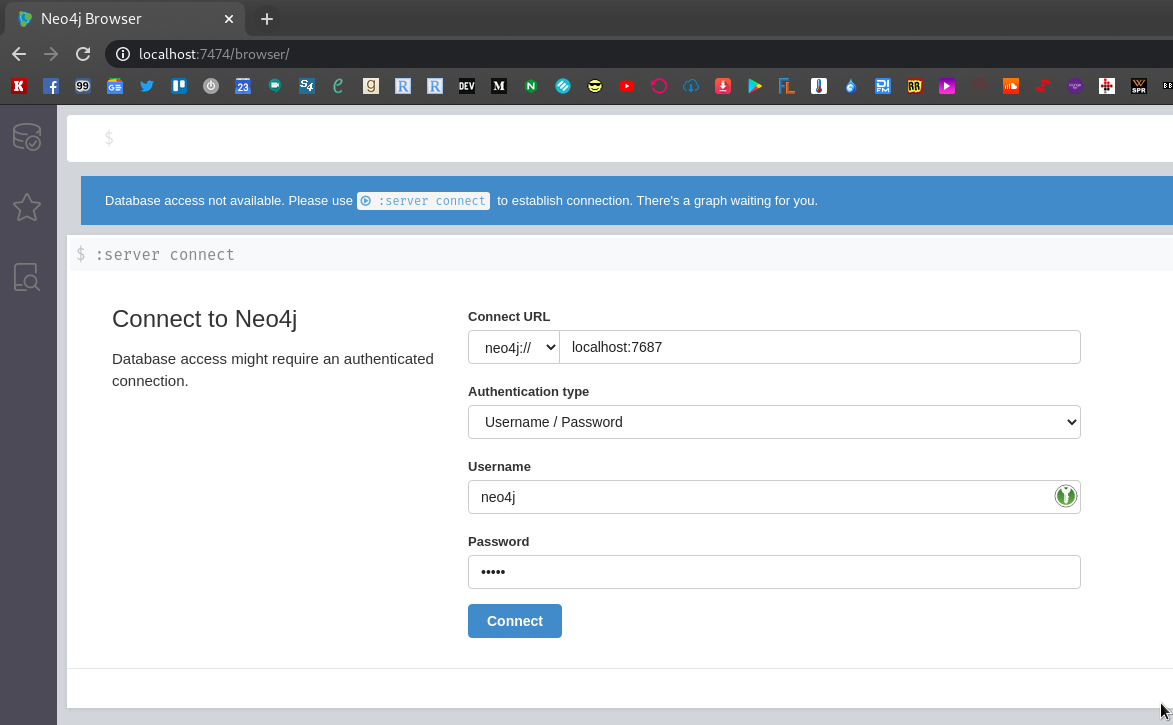
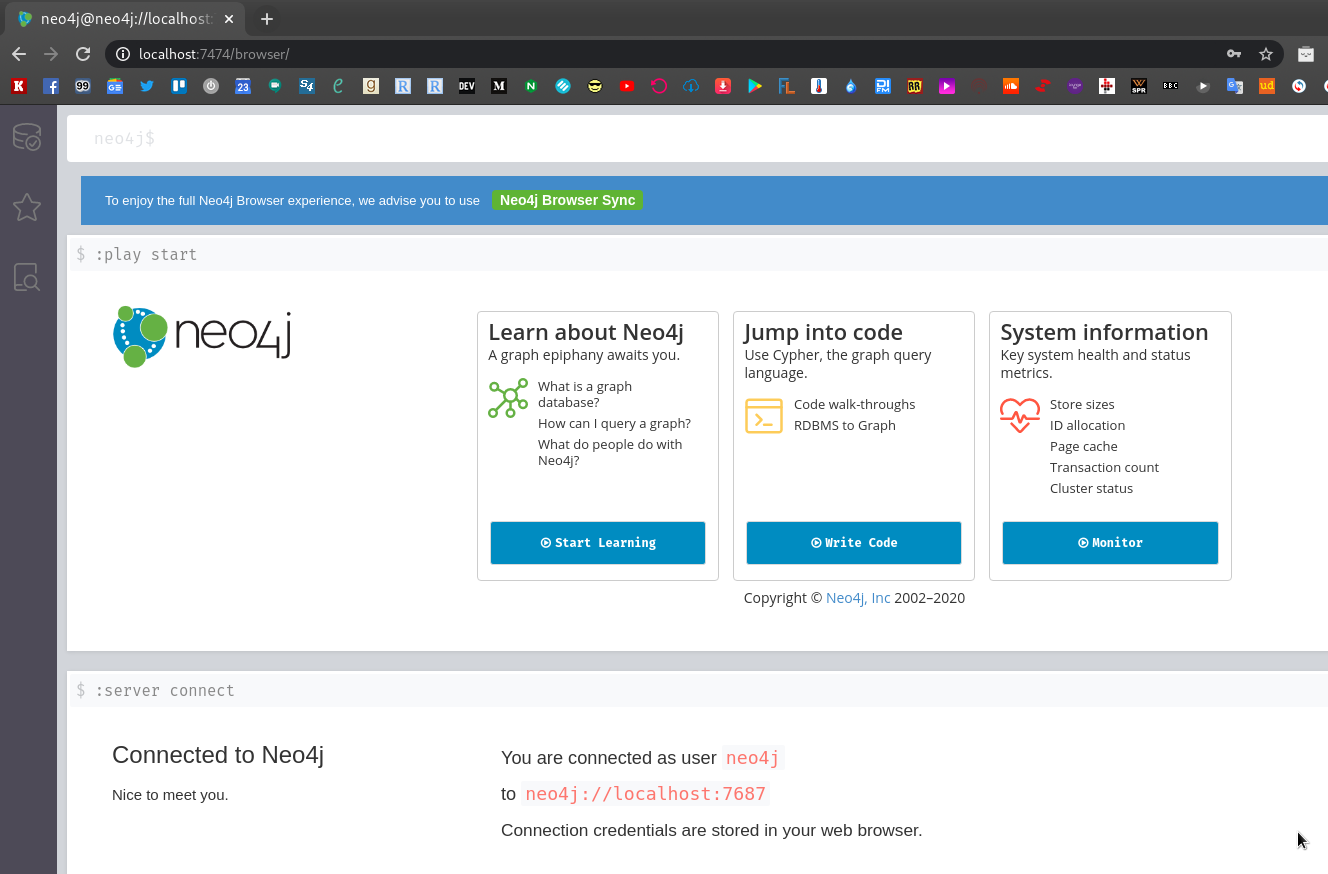
Admin password
To set a new password – use the --env NEO4J_AUTH:
docker run --rm --name neo4j --env NEO4J_AUTH=neo4j/pass -p 7474:7474 -p 7687:7687 neo4j:latest
Changed password for user 'neo4j'.
...
nothing-shell
To piece of work with the databases yous tin use Remainder API or a local tool – cypher-vanquish.
Connect to the container and ruin the shell:
docker exec -ti neo4j cypher-beat out -u neo4j -p pass
Connected to Neo4j iv.1.0 at neo4j://localhost:7687 every bit user neo4j.
Type :help for a list of bachelor commands or :leave to exit the shell.
Note that Zero queries must cease with a semicolon.
Neo4j configuration file
In the container, the main configuration file located at the $NEO4J_HOME/conf/neo4j.conf path, eastward.g. /var/lib/neo4j/conf/neo4j.conf:
[e-mail protected]:/var/lib/neo4j# caput /var/lib/neo4j/conf/neo4j.conf
*****************************************************************
Neo4j configuration
For more details and a complete list of settings, please see
https://neo4j.com/docs/operations-manual/current/reference/configuration-settings/
*****************************************************************
The proper name of the default database
dbms.default_database=neo4j
To redefine any setting – mount anew config file to the /conf directory of the container.
All settings for the neo4j.conf tin can exist plant here>>>.
To get current config from the shell – use the dbms.listConfig() call:
YIELD name, value
WHERE name STARTS WITH 'dbms.default'
Render proper noun, value
Lodge BY name
LIMIT 3;
+-------------------------------------------------+
| proper name | value |
+-------------------------------------------------+
| "dbms.default_advertised_address" | "localhost" |
| "dbms.default_database" | "neo4j" |
| "dbms.default_listen_address" | "0.0.0.0" |
+-------------------------------------------------+
3 rows available after 216 ms, consumed later on another xiii ms
zip-beat out && CQL
CREATE
Let's play with information.
In that location is a great tutorial of the data types on the Tutorialspoint hither>>>.
Create a new node:
0 rows bachelor after 56 ms, consumed after another 0 ms
Added 1 nodes
DELETE
Delete it:
0 rows available after 32 ms, consumed after another 0 ms
Deleted 1 nodes
To delete all records from a database – use the (north):
Labels
Create a node with the label1 label with the Backdrop which holds two keys – key1 and key2:
[email protected]> create (node1:label1 {key1: "value1", key2: "value2"} );
0 rows available subsequently 47 ms, consumed afterward another 0 ms
Added 1 nodes, Ready two backdrop, Added one labels
Bank check it:
+--------------------------------------------+
| node1 |
+--------------------------------------------+
| (:label1 {key1: "value1", key2: "value2"}) |
+--------------------------------------------+
Or by using Return – go the node right after creation, in the same query:
[email protected]> CREATE (node2:label2 {key1: "value1", key2: "value2"} ) RETURN node2;
+--------------------------------------------+
| node2 |
+--------------------------------------------+
| (:label2 {key1: "value1", key2: "value2"}) |
+--------------------------------------------+
Check from the browser using lucifer(due north) return n to display all the records:
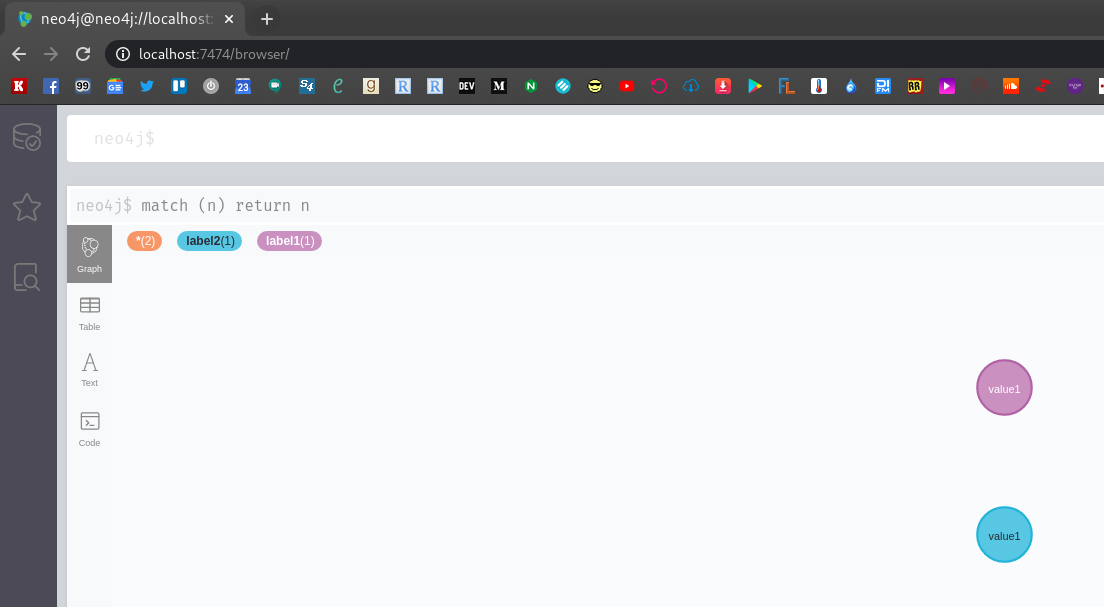
Relations
A new relationship can exist created between any new nodes, or between already existing.
To create a Relation between new nodes – add the -[r:RelationName]->:
[email protected]> create (node3:label3 {key1: "value1", key2: "value2"}) -[r:RelationName]-> (node4:label4{key1: "value1", key2: "value2"}) RETURN node3, node4;
+-----------------------------------------------------------------------------------------+
| node3 | node4 |
+-----------------------------------------------------------------------------------------+
| (:label3 {key1: "value1", key2: "value2"}) | (:label4 {key1: "value1", key2: "value2"}) |
+-----------------------------------------------------------------------------------------+
1 row available later on 88 ms, consumed subsequently some other 8 ms
Added two nodes, Created 1 relationships, Set 4 properties, Added 2 labels
Check it:
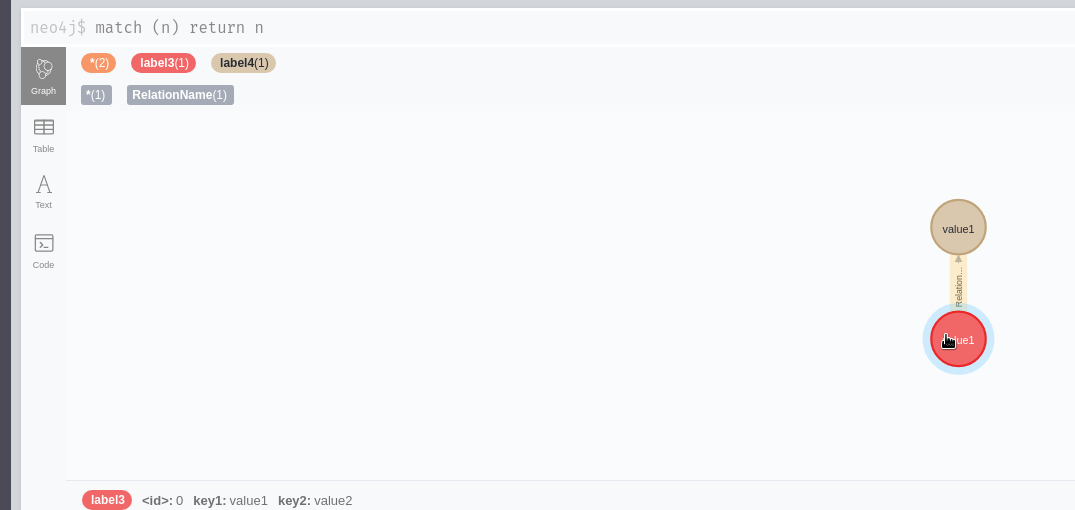
To create a Relation between already existing nodes – employ MATCH to select those nodes:
[email protected]> MATCH (node3:label3), (node4:label4) CREATE (node3) -[r:RelationName2]-> (node4) Render node3, node4;
+-----------------------------------------------------------------------------------------+
| node3 | node4 |
+-----------------------------------------------------------------------------------------+
| (:label3 {key1: "value1", key2: "value2"}) | (:label4 {key1: "value1", key2: "value2"}) |
+-----------------------------------------------------------------------------------------+
1 row bachelor after 124 ms, consumed later on another 9 ms
Created 1 relationships
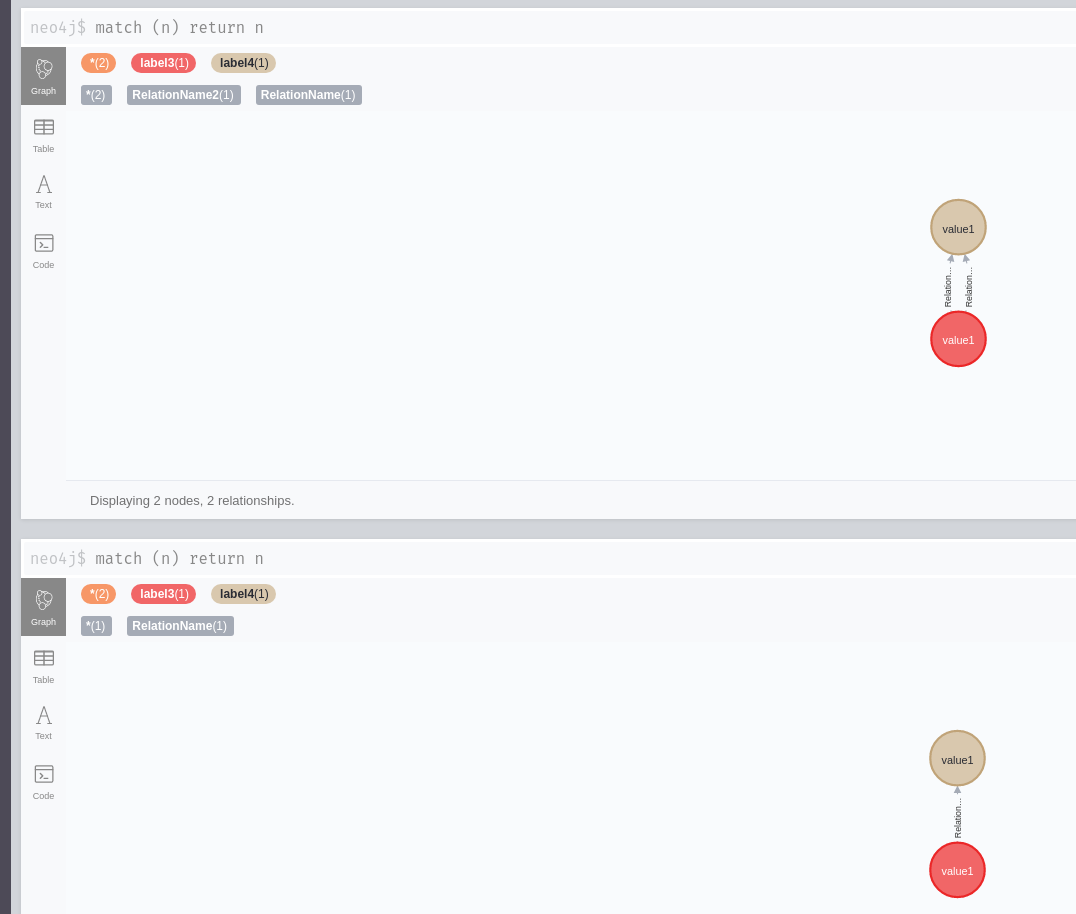
Backup && Restore
Information is stored in the $NEO4J_HOME/data which is actually a symlink to the /information, see here>>>.
Check directories:
lrwxrwxrwx 1 root root 5 Jul 23 09:01 /var/lib/neo4j/data -> /information
full 12
drwxrwxrwx four neo4j neo4j 4096 Jul 27 11:xix databases
drwxr-xr-10 2 neo4j neo4j 4096 Jul 27 11:nineteen dbms
drwxrwxrwx 4 neo4j neo4j 4096 Jul 27 11:19 transactions
Databases files are stored in the databases directory, where y'all can find two default databases – the organisation and neo4j, which can be establish with the show databases:
+------------------------------------------------------------------------------------------------+
| name | accost | role | requestedStatus | currentStatus | error | default |
+------------------------------------------------------------------------------------------------+
| "neo4j" | "localhost:7687" | "standalone" | "online" | "online" | "" | TRUE |
| "system" | "localhost:7687" | "standalone" | "online" | "online" | "" | FALSE |
+------------------------------------------------------------------------------------------------+
The organisation database is used for the… Well, for the system itself, while nedo4j is the default user database.
Neo4j dump
Create a new directories which will hold our data:
mkdir -p /tmp/neo4/{data,logs}
Restart the Neo4j container, mount those directories to it:
docker run --rm --name neo4j --env NEO4J_AUTH=neo4j/pass -p 7474:7474 -p 7687:7687 -v /tmp/neo4/information/:/information -v /tmp/neo4/logs/:/logs neo4j:latest
Changed password for user 'neo4j'.
Directories in use:
dwelling: /var/lib/neo4j
config: /var/lib/neo4j/conf
logs: /logs
plugins: /var/lib/neo4j/plugins
import: /var/lib/neo4j/import
data: /var/lib/neo4j/data
certificates: /var/lib/neo4j/certificates
run: /var/lib/neo4j/run
...
Check the data on the host:
ll /tmp/neo4/data/databases/
total 0
drwxr-xr-10 ii 7474 7474 720 Jul 27 16:07 neo4j
-rw-r--r-- 1 7474 7474 0 Jul 27 16:07 store_lock
drwxr-xr-ten 3 7474 7474 740 Jul 27 16:07 system
Connet, create a new tape:
docker exec -ti neo4j nothing-trounce -u neo4j -p pass
0 rows available after 131 ms, consumed later another 0 ms
Added i nodes
To create a database dump you start need to stop the instance (as the Community Edition doesn't have ability for the online backups):
[e-mail protected]:/var/lib/neo4j# neo4j-admin dump --database=neo4j --to=/data/backups/
The database is in use. Stop database 'neo4j' and try again.
So, exit from the container and stop it:
Start it over but at this fourth dimension add the bash command to prevent Neo4j service from starting:
docker run -ti --rm --name neo4j --env NEO4J_AUTH=neo4j/pass -p 7474:7474 -p 7687:7687 -5 /tmp/neo4/data/:/data -v /tmp/neo4/logs/:/logs neo4j:latest fustigate
Create a dump:
[electronic mail protected]:~$ neo4j-admin dump --database=neo4j --to=/data/backup/
Done: 34 files, 250.8MiB processed.
Check it:
total 12
-rw-r--r-- 1 neo4j neo4j 9971 Jul 27 thirteen:46 neo4j.dump
Restore
On the host create a new set of directories – for the second Neo4j instance:
mkdir -p /tmp/neo4-2/{data,logs}
Copy the backups directory from the commencement i:
sudo cp -r /tmp/neo4/data/backup/ /tmp/neo4-two/information/
Run the service as usual, mount the /tmp/neo4-2, replace ports and its name:
docker run --rm --name neo4j-ii --env NEO4J_AUTH=neo4j/laissez passer -p 7475:7474 -p 7688:7687 -five /tmp/neo4-two/information/:/data -five /tmp/neo4-two/logs/:/logs neo4j:latest
Connect and check the information:
docker exec -ti neo4j-two cypher-shell -u neo4j -p pass
Continued to Neo4j iv.1.0 at neo4j://localhost:7687 equally user neo4j.
Blazon :help for a list of available commands or :get out to exit the shell.
Note that Cypher queries must end with a semicolon.
+---+
| n |
+---+
+---+
Okay – zilch establish here as this is a make new database.
Exit from the container, stop it and run over with the bash:
docker run -ti --rm --name neo4j-two --env NEO4J_AUTH=neo4j/pass -p 7475:7474 -p 7688:7687 -v /tmp/neo4-2/information/:/data -v /tmp/neo4-2/logs/:/logs neo4j:latest bash
Load the dump to the database with the --force fundamental equally the default neo4j database already present:
[electronic mail protected]:~$ neo4j-admin load --from=/data/backup/neo4j.dump --database=neo4j --force
Done: 34 files, 250.8MiB processed.
Leave, restart container once again in the normal manner to start the Neo4j process:
docker run -ti --rm --name neo4j-2 --env NEO4J_AUTH=neo4j/pass -p 7475:7474 -p 7688:7687 -v /tmp/neo4-2/information/:/data -v /tmp/neo4-ii/logs/:/logs neo4j:latest
Connect, check:
+-------------+
| n |
+-------------+
| (:tobackup) |
+-------------+
Our record is on its place – all washed.
Also published on Medium.
Source: https://rtfm.co.ua/en/neo4j-graph-database-run-with-docker-and-cypher-ql-examples/
0 Response to "The Database Is in Use Stop Neo4j and Try Again"
Postar um comentário